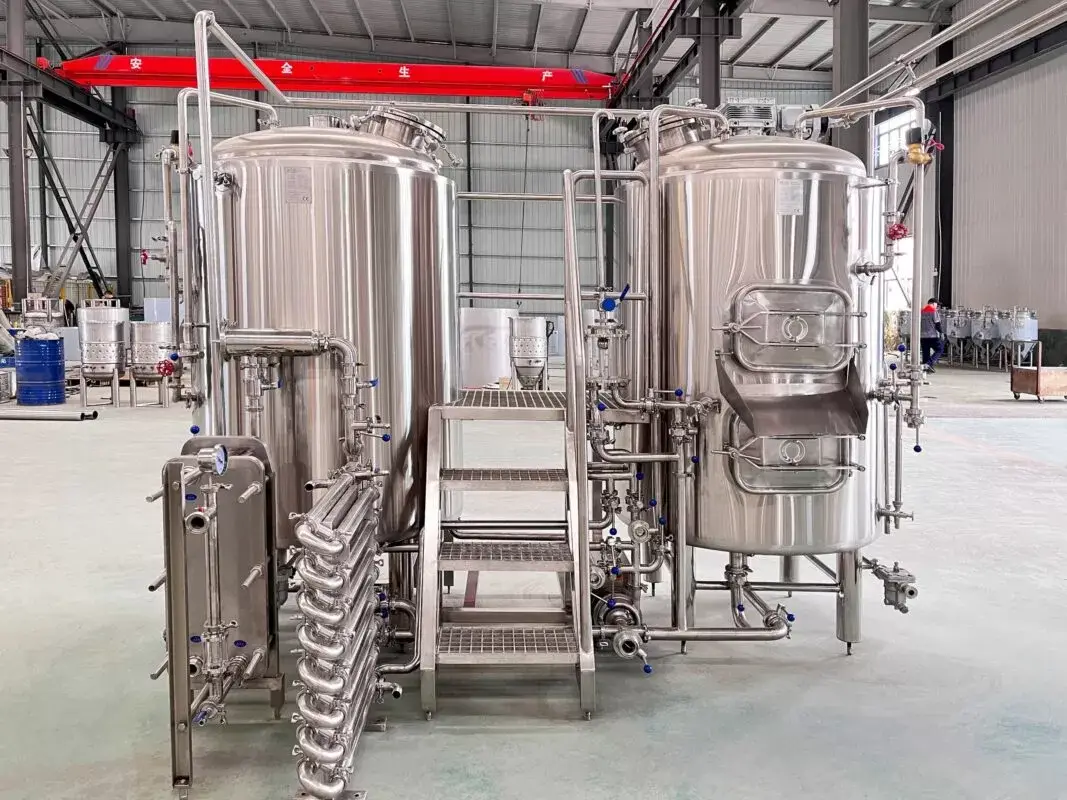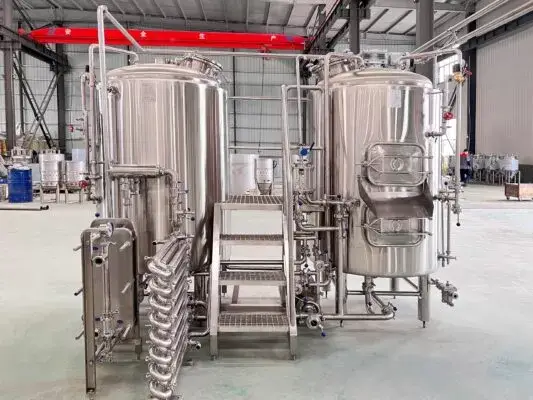equipo de elaboración de alcohol Requiere equipo especializado para producir cervezas, vinos, licores y otras bebidas alcohólicas. Esta guía proporciona un resumen de los tipos de equipos clave, consideraciones para seleccionar e instalar sistemas y proveedores.
Tipos de equipos de elaboración de alcohol
| Equipamiento | Descripción |
|---|---|
| Hervidores de cerveza | Recipientes calentados para triturar granos y hervir mosto. Disponible en acero inoxidable o cobre. Los tamaños varían de 5 a 20 barriles. |
| Tanques de fermentación | Tanques de acero inoxidable o plástico que permiten una fermentación alcohólica controlada. Clasificado por volumen de lote, normalmente de 10 a miles de barriles. |
| Control de la temperatura | Elementos de calefacción y refrigeración, como enfriadores de glicol, para regular la temperatura del tanque. |
| Tuberías, válvulas, bombas. | Hardware para transferir líquidos, regular flujo, limpiar equipos. Manual o automatizado. |
| Control de procesos | Sensores, equipos de automatización y software para monitorear y controlar la elaboración de cerveza. |
| Línea de embotellado/enlatado | Maquinaria de alta velocidad llena/tapa botellas o latas. Semi o totalmente automatizado. |
| Manipulación del grano | Molinos, transportadores y silos para entregar y procesar granos. El grado de automatización varía. |
Factores de personalización
Las cervecerías tienen necesidades de equipos únicas basadas en objetivos de producción, presupuestos, personal y limitaciones de espacio. Factores clave de personalización:
| Factor | Opciones |
|---|---|
| Tamaño del lote | Desde sistemas de 5 bbl hasta grandes sistemas industriales. |
| Nivel de automatización | Desde equipos manuales hasta salas de cocción totalmente automatizadas. |
| Opciones de poder | Calefacción eléctrica, de gas o de vapor; glicol versus enfriamiento por expansión directa; voltaje de automatización |
| Materiales | Acero inoxidable, cobre, plástico: impacto en la durabilidad, el mantenimiento y el sabor |
| Disposición | El espacio disponible, el flujo de trabajo y la ergonomía influyen en la huella y el posicionamiento del equipo |
equipo de elaboración de alcohol Proveedores y costos
Muchos PROVEEDORES ofrecen venta, instalación y mantenimiento de equipos cerveceros. Los precios varían ampliamente según las características y la personalización.
| Empresa | Ofertas | Precios |
|---|---|---|
| cervecería | Salas de cocción totalmente automatizadas | $100.000 a $2M+ |
| JV Noroeste | Sistemas manuales y automatizados. | $50.000 a $750.000 |
| American Beer Equipment | Calderas, tanques y tuberías para preparar cerveza | $5.000 a $1M |
Factors influencing the price of alcohol brewing equipment
Whether you’re a weekend warrior whipping up a small batch of experimental pale ale or a seasoned distiller crafting award-winning whiskey, understanding the factors influencing the price of alcohol brewing equipment is crucial. The cost can vary wildly, from a few dozen dollars for a basic homebrew kit to hundreds of thousands (or even millions) for professional setups. So, what separates a budget-friendly bubbler from a top-of-the-line brewery behemoth? Let’s delve into the key cost drivers:
Scale and Ambition: This is the big one. The size and capacity of your equipment directly impact the price tag. A homebrew setup producing gallons at a time naturally costs less compared to a commercial brewery churning out kegs. Consider your needs – are you brewing for personal enjoyment or aiming for mass production?
Material Matters: Stainless steel reigns supreme in the world of brewing equipment. It’s durable, easy to clean, and imparts minimal flavor to your creations. However, it comes at a premium compared to options like plastic or food-grade buckets. Upgrading to features like double-walled insulation or specialized metals can further bump up the price.
Automation Adds Up: Manual systems require elbow grease, while automated ones take care of the heavy lifting (and heating, and cooling). While convenient, automation comes at a cost, with features like temperature control units and programmable fermentation cycles driving up the price tag.
Brand Prestige: Established brands with a reputation for quality and reliability often command higher prices. They may offer superior warranties, craftsmanship, and after-sales support, justifying the premium for some brewers. However, value-driven options from lesser-known brands can be just as effective.
Specialized Styles: Brewing specific types of alcohol like sours, kombucha, or spirits often requires unique equipment. Pressure cookers, specialized fermenters, and distillation columns add complexity and cost, catering to a niche market.
Location, Location, Location: Geography plays a surprising role. Importing equipment can incur additional costs due to shipping, taxes, and currency fluctuations. Local manufacturers or used equipment marketplaces can offer more budget-friendly options.
Remember, it’s an investment: While the initial cost might seem daunting, consider brewing equipment as an investment. High-quality tools can last for years, producing countless batches of your favorite beverages. Evaluate your long-term brewing goals and choose equipment that fits your budget and ambitions.
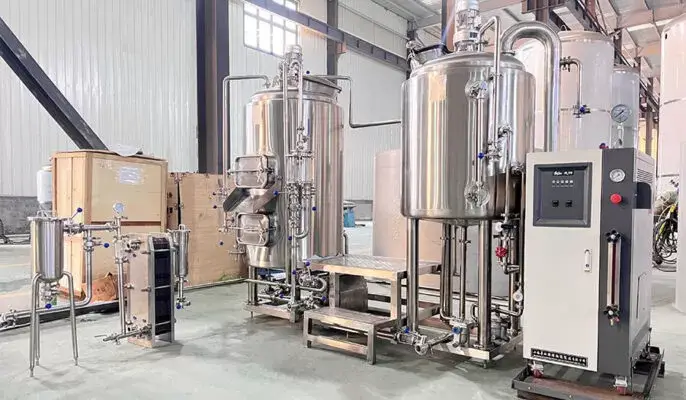
Consideraciones de compra y operación
Elegir un proveedor y un sistema adecuados requiere evaluar muchos factores:
| Factores de compra | Factores operativos |
|---|---|
| Calidad del equipo, confiabilidad, garantía. | Eficiencia energética, costes operativos. |
| Reputación y experiencia de la empresa. | Requisitos de mantenimiento |
| Capacidades de personalización, flexibilidad. | Necesidades de formación del personal. |
| Presupuesto | Procedimientos de limpieza y productos químicos. |
| Plazo de entrega para fabricación y entrega. | Cumplimiento de normativas, inspecciones. |
Los criterios de evaluación dependerán de los objetivos, las finanzas y la tolerancia al riesgo de cada cervecería. La mayoría tiene como objetivo optimizar el rendimiento dentro de las limitaciones presupuestarias.
Esta descripción general cubre los equipos comunes en las instalaciones de producción de alcohol. Existen muchas variaciones y adiciones, como sistemas de destilación para bebidas espirituosas o trituradoras para la elaboración de vino. Los cerveceros pueden personalizar aún más con complementos como laboratorios de control de calidad para probar el contenido de alcohol, los perfiles de sabor y la calidad. Con una selección y operación cuidadosas, los equipos de elaboración de cerveza permiten una producción de alcohol eficiente y consistente en volúmenes y costos objetivo.
Seleccionar los tanques de fermentación adecuados
Los tanques de fermentación son un componente crítico para controlar el proceso de producción de alcohol. Los cerveceros deben evaluar muchos factores al seleccionar los tanques:
Dimensionamiento del tanque
Tiny Titans: Perfect for the curious experimenter, 1-gallon jugs or carboys offer a compact and budget-friendly entry point. Ideal for testing new recipes or crafting personal-sized batches, they fit snugly in kitchens and apartments.
Weekend Warriors: Scaling up to 5-gallon carboys or kettles opens doors to more variety and sharing. This popular size caters to the casual brewer who enjoys sharing their creations with friends and family, offering enough volume for several six-packs without overwhelming your space.
Homebrew Heroes: Stepping into the 10-gallon territory signifies a commitment to the craft. This size allows for multiple smaller batches or larger, single-batch brews, catering to those who enjoy the process as much as the final product. Think weekly brewing sessions or supplying small gatherings.
Small-Scale Stars: For those dreaming of microbrewery-style production, 20-30 gallon kettles and fermenters offer a significant leap. This size caters to ambitious brewers who envision consistent production, supplying local markets, or hosting bigger events. Remember, space and cleaning demands also scale up!
Beyond the Norm: Pushing past the 30-gallon mark signifies serious business. These setups, often modular or stackable, cater to established brewers or aspiring entrepreneurs aiming for larger-scale production and distribution. Be prepared for dedicated brewing spaces and significant investments.
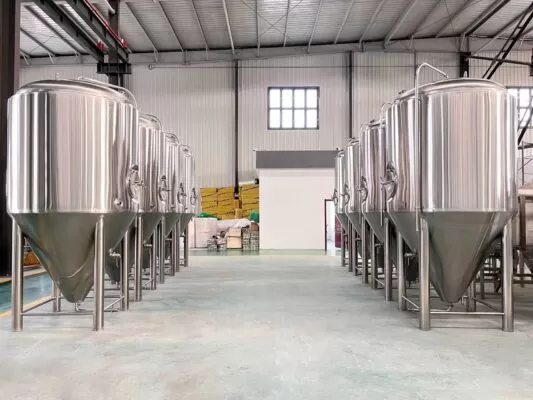
Material del tanque
When it comes to choosing equipment for your alcohol brewing adventures, the tank material plays a crucial role in shaping your experience. Each option boasts unique advantages and drawbacks, and understanding them is key to making an informed decision. Let’s explore the most common contenders:
The King of Durability: Stainless Steel
Reigning supreme in the brewing world, stainless steel stands out for its exceptional durability, resistance to corrosion, and ease of cleaning. It imparts minimal flavor to your creations and withstands the rigors of sanitization and temperature shifts. However, its robustness comes at a premium, making it the pricier option.
Budget-Friendly Choice: Plastic
For cost-conscious brewers, plastic offers a more affordable alternative. Food-grade plastic containers and buckets are perfect for smaller-scale brewing or initial experimentation. However, some plastics can leach chemicals into your brew and might not withstand high temperatures as well as stainless steel. They are also more susceptible to scratches and staining.
The Traditional Touch: Wood
Wooden barrels infuse your creations with unique flavors and textures, adding a touch of history and character to your brews. Oak is the preferred choice for aging spirits like whiskey and cider, while other woods like cherry can complement specific beers. However, wood requires extensive maintenance, is prone to leaks, and can be challenging to clean, making it a niche option for dedicated enthusiasts.
The Glass Advantage: Clarity and Ease of Viewing
For visual observation and small-scale brewing, glass carboys offer undeniable benefits. You can directly witness the fermentation process unfolding, making them ideal for educational purposes or experimenting with new techniques. However, glass is fragile and requires careful handling, making it less suitable for larger setups or frequent use.
Beyond the Norm: Specialized Options
For specific brewing styles or unique needs, you might encounter more specialized materials like aluminum, copper, or even concrete. Each offers distinct advantages and limitations, tailored to specific applications. Researching their suitability for your chosen style is crucial.
Control de la temperatura
Simple Solutions for Casual Brewers:
For small-scale setups or those starting their brewing journey, basic methods like water baths or ice packs offer simple, budget-friendly options. While requiring more manual intervention, they can be effective for maintaining consistent temperatures, especially for styles with less stringent requirements.
Dialing it In: Immersion Chillers and Heating Elements:
These workhorses of temperature control directly interact with your brewing vessel. Immersion chillers use a coil submerged in your wort or fermenter to efficiently cool your brew, while heating elements provide precise temperature control during mashing or boiling. They offer more control than passive methods but require compatible equipment and some technical knowledge.
Automation Takes the Reins: Temperature Controllers:
Elevating your game? Consider a dedicated temperature controller. This handy device acts as the brain of your setup, monitoring and adjusting temperature based on pre-programmed settings. They often pair with immersion chillers or heating elements, automating the process and ensuring consistent results.
The All-in-One Approach: Fermentation Chambers:
For ultimate control and convenience, fermentation chambers take things to the next level. These insulated enclosures house your fermenters and provide precise temperature control, often with programmable profiles for different fermentation stages. While a substantial investment, they offer unparalleled control and consistency, ideal for serious brewers or those venturing into temperature-sensitive styles.
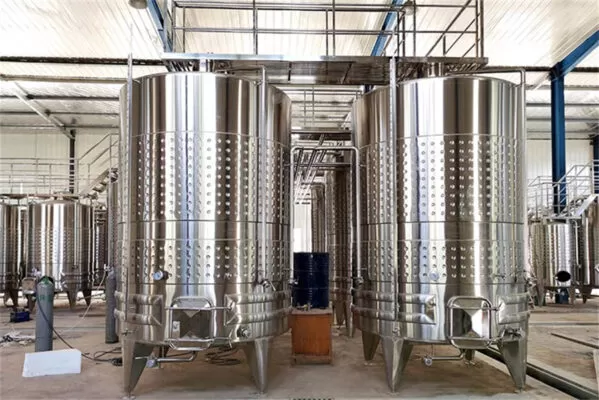
equipo de elaboración de alcohol Limpieza y mantenimiento
Para mantener la calidad del equipo y del producto, los cerveceros siguen estrictos procedimientos de limpieza entre lotes utilizando sistemas de limpieza in situ (CIP).
| Método | Función | Productos químicos utilizados |
|---|---|---|
| Lavado cáustico | Elimina residuos orgánicos | Hidróxido de sodio, hipoclorito de sodio. |
| Lavado con acido | Elimina incrustaciones y depósitos minerales. | Ácido nítrico, fosfórico o sulfúrico |
| Esterilización | Mata las bacterias | Isopropanol, peróxido de hidrógeno, ozono. |
Los controles de mantenimiento diarios y semanales también garantizan un funcionamiento adecuado:
- Inspeccionar tanques y válvulas en busca de fugas.
- Verificar que los sensores de temperatura y los sistemas de automatización estén bien calibrados.
- Verifique el flujo de tuberías y sistemas de bombeo como se esperaba
- Revisar registros para tendencias de análisis
- Prueba de eficacia de limpieza
Seguir las mejores prácticas de limpieza y mantenimiento ayuda a que los equipos de fermentación funcionen constantemente con el máximo rendimiento durante años.
PREGUNTAS FRECUENTES
| Pregunta | Respuesta |
|---|---|
| ¿Cuál es el equipo más crítico para iniciar una microcervecería? | Para la elaboración de cerveza a pequeña escala, las piezas clave son una tetera, tanques fermentadores con control de temperatura y una línea de embotellado. El manejo de granos y otras automatizaciones se pueden agregar más adelante si aumenta la producción. |
| ¿Qué factores debo considerar para la distribución y el espacio del equipo? | Considere los tamaños de los equipos, el flujo de trabajo de producción, la ergonomía, la ventilación, el acceso a los servicios públicos y el espacio para ampliar o agregar tanques. Obtenga asesoramiento sobre diseño de un proveedor de equipos o un consultor de cervecería. |
| ¿Debo elegir equipo automático o manual? | Las salas de cocción automatizadas simplifican la operación en instalaciones de gran volumen. Los sistemas manuales brindan flexibilidad y control práctico para los cerveceros artesanales más pequeños y cuestan menos. Evalúe las compensaciones en función de los objetivos de producción, el presupuesto y las capacidades del personal. |




